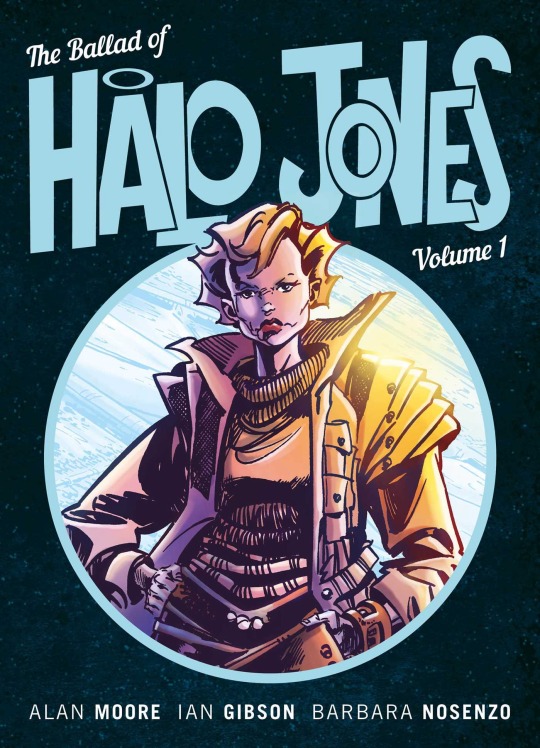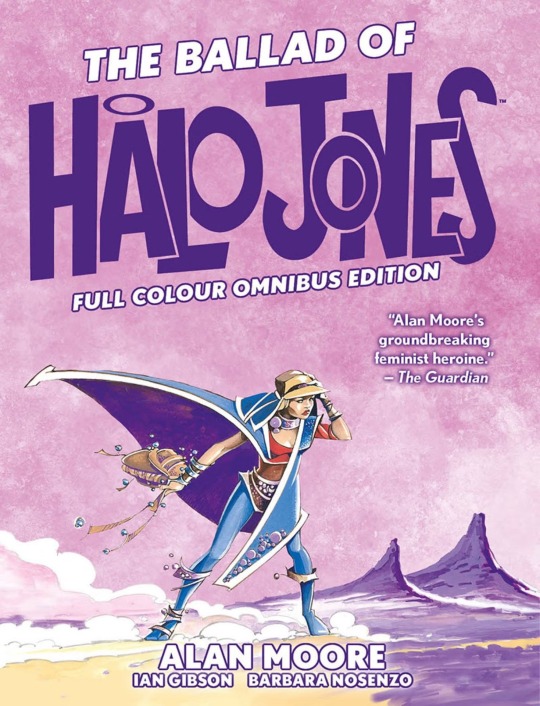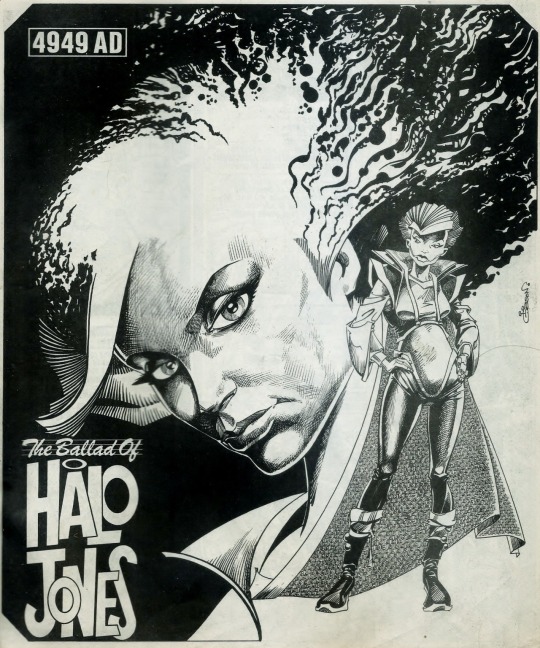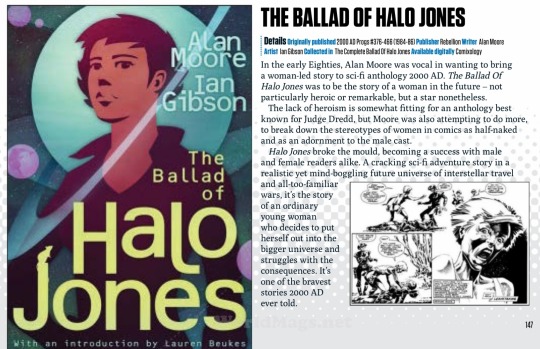#The Ballad of Halo Jones
Explore tagged Tumblr posts
Text
British creators Liam Sharp, Richard Starkings and Bryan Talbot, among 2024 Eisner Award nominees
Comic-Con International announced the 2024 nominations for the Will Eisner Comic Industry Awards last week, and once again, there are many British creators among them, including Liam Sharp, Richard Starkings, and Bryan Talbot and Zoe Thorogood

View On WordPress
#2000AD#Adventure Comics#Carol Day#Comic-Con International#Conan the Barbarian#David Wright#downthetubes News#Eisner Awards#Liam Sharp#Michael Molcher#Rebellion#Richard Starkings#SF Comics#Slingsby Bros Ink!#The Ballad of Halo Jones#Titan Comics#Will Eisner Comic Industry Awards#Zoe Thorogood
9 notes
·
View notes
Text

The Ballad of Halo Jones
Alan Moore, Ian Gibson, and Steve Potter
#comics#comic books#art#illustration#panelswithoutpeople#b&w#black and white#2000 a.d.#2000 ad#The Ballad of Halo Jones#halo jones#alan moore#ian gibson#steve potter#rat king
3 notes
·
View notes
Text

The Ballad of Halo Jones, volume 1 This is one of those 2000 AD series that I've heard about several times over the years, and now I've finally read it. This volume contains ten chapters (2000 AD is an anthology magazine, similar to Shonen Jump, so each chapter is fairly short), which comprise a sort of origin or prelude, taking 18-year-old Halo from her home on the Hoop to the very beginning of her journeys in space. The story takes place in the 50th century, on a ring-shaped habitat called the Hoop, which floats in the Atlantic near New York City. This is a place for people who are down on their luck. Halo shares an apartment with three other women. Most of them dream of going somewhere else, but they don't expect it will really happen. I like seeing protagonists from "lower" economic classes. I expect there are a lot of references to life in the UK's council flats that goes over my head. The stories start off as purposely confusing, to get across how strange this future is. Space travel seems to be commonplace (though not affordable by many), and at least one species of alien lives on Earth. Dialog is littered with invented slang, which was a bit off putting, but it does make more sense over time, and it decreases as the stories continue (at least in this volume). Some of the stories are pretty comedic, but take a very serious turn just before the end, then closes on a hopeful note. I like Halo, and I want to see where the next volume takes her. I also like seeing the setting slowly revealed. There are some cool science fiction ideas here, and even the ones that don't appeal so much to me are still interesting.
#halo jones#the ballad of halo jones#2000 ad#comics#comic books#comic book cover art#uk comics#sci-fi comics#sci-fi
2 notes
·
View notes
Text








The Ballad of Halo Jones by Ian Gibson (20 February 1946 – 11 December 2023) RIP
9 notes
·
View notes
Text

100 all time greatest comics (2014)
3 notes
·
View notes
Text

The Ballad of Halo Jones
by Alan Moore; Ian Gibson and Steve Potter
Rebellion and 2000AD
13 notes
·
View notes
Text
#comic review#absolute wonder woman#ultimate x men#the ballad of halo jones#klaus#dc comics#marvel comics#boom studios#2000 ad#alan moore#ian gibson#peach momoko#grant morrison#dan mora#kelly thompson
1 note
·
View note
Text
RIP Ian Gibson

Halo Jones by Ian Gibson
10 notes
·
View notes
Text
i've begun working on a rudimentary personal spreadsheet to start exploring 2000AD related comics because that's just a completely unexplored aspect of comics for me and I want to fill it in
1 note
·
View note
Note
Hello Neil, big fan of your work. I’ve noticed you’ve done a few Tharg’s future shocks for 2000AD. Are you a fan of some 2000AD/ Starlord books? if so what are some of your favourite stories or future shocks?
For me it's D.R. AND QUINCH and THE BALLAD OF HALO JONES.
255 notes
·
View notes
Text

Alan Moore & Ian Gibson: The Ballad of Halo Jones, Book Three (1986)
2 notes
·
View notes
Text
In Memoriam: Comic Artist and Writer Ian Gibson
We're sorry to report Ian Gibson, perhaps best known for his work on 2000AD, passed on in the early hours of Monday 11th December 2023, after a long illness

View On WordPress
#2000AD#downthetubes News#Ian Gibson#John Wagner#Pat Mills#SF Comics#Steve Bull#The Ballad of Halo Jones
24 notes
·
View notes
Text

The Ballad of Halo Jones
Alan Moore, Ian Gibson, and Steve Potter
#comics#comic books#art#illustration#panelswithoutpeople#b&w#black and white#alan moore#ian gibson#steve potter#halo jones#the ballad of halo jones#2000 a.d.#2000 ad#space#sci-fi#sci fi#science fiction#spaceship
2 notes
·
View notes
Text
youtube
Fantastic retro TV ad from 1977 for British newsstand stalwart “2000 AD”, celebrating the release of issue 1 and its hard-to-find free SPACE SPINNER. Never has a piece of plastic been seared into the minds of a generation so permanently. The ad’s presenter is long-serving alien editor THARG.
"2000 AD" is a British weekly science fiction comic magazine that debuted in 1977, created by writer and editor Pat Mills. Known for its gritty, satirical, and often anarchic style, the magazine quickly set itself apart from other comics of the time. Early issues featured a mix of science fiction stories, including "Flesh," "Invasion," and "Harlem Heroes." The publication became a launchpad for many notable creators, such as Alan Moore, who wrote "The Ballad of Halo Jones," and Grant Morrison, who created "Zenith." Other influential contributors included Garth Ennis and Dave Gibbons, each adding to the magazine's diverse and innovative storytelling.
Judge Dredd made his debut in the second issue of "2000 AD" on 5 March 1977, and swiftly became its flagship character. Created by writer John Wagner and artist Carlos Ezquerra, Judge Dredd is a law enforcement officer in the dystopian future city of Mega-City One, known for his strict adherence to the law. Alongside Dredd, other notable characters like Johnny Alpha from "Strontium Dog," Rogue Trooper, Slaine, and Nemesis the Warlock helped define the magazine's unique blend of dark humour, social commentary, and imaginative storytelling. "2000 AD" has maintained its status as a cornerstone of British pop culture, continuing to publish weekly and influencing generations of comic creators and fans.
Jason Kingsley Rebellion Film Studios 2000 AD
#2000AD #JudgeDredd #MegaCityOne #ThargTheMighty #PatMills #JohnWagner #CarlosEzquerra #AlanMoore #GrantMorrison #GarthEnnis #DaveGibbons #TheBalladOfHaloJones #Zenith #StrontiumDog #RogueTrooper #Slaine #NemesisTheWarlock #DurhamRed #JudgeAnderson #SamSlade #RoboHunter #ABCWarriors #CursedEarth #JudgeDeath #TheDarkJudges #Prog2000 #FutureShocks #RebellionPublishing #2000ADArt #2000ADComics
#comics#comicart#comicbooks#tftqcomic#comiccon#comicartist#comicstrip#comiccollector#comicsforsale#comic#Youtube
3 notes
·
View notes
Note
How would you rank Alan Moore’s major works?
Watchmen comes first, because it contains everything he can do done to perfection. Its crystalline structure holds all his contradictions in a sustaining tension, his heart and his head perfectly aligned in one of the most beguiling fictional heterocosms I have ever had the pleasure of entering. I've read it more times than I've read anything, to be honest, and I'm not tired of it yet.
From Hell is also an extraordinary literary achievement, not at all diminished if placed next to comparable or roughly contemporaneous works by Pynchon or McCarthy—I've compared Sir William Gull to Judge Holden—and heartfelt in its own way, if also at an extreme of horror hard to match elsewhere in serious fiction.
There's a lot of dross in the Swamp Thing run, but I love its first and final third, everything before and after the relatively bad "American Gothic," because it's almost all heart, an outpouring of lyricism like nothing else before in comics, the imitation of which would launch Gaiman and Morrison down their own paths.
The Lovecraft material probably has to come next—The Courtyard, Neonomicon, and Providence—his most truly substantial comics work of this century and a profound and ambivalent meditation on how the pop and cult fiction of the last century created our present reality. It's about as horrifying as From Hell, however, with its entire chapter of interspecies rape to balance From Hell's entire chapter of misogynist murder.
Tied for fifth, almost of necessity, are the didactic series Promethea and the prose novel Voice of the Fire. To understand post-1980s Moore, you must understand magic, and these two works, uneven as they might be, suggest what magic means to Moore. Promethea, anyway, for all its faults, is often a pleasant post-Vertigo throwback to the proto-Vertigo qualities of Swamp Thing, while Voice of the Fire—a book a few years ahead in English literature of the technique David Mitchell would be celebrated for in Ghostwritten and especially Cloud Atlas, though both Moore and Mitchell borrow from a book I've never read, Riddley Walker—has passages of such scorching intensity you could put them next to any contemporaneous novelist.
So that's my top five (or top six). Miracleman is too disunified, so clumsy at inception and so polished in conclusion, though Book Three is remarkable. Neither V for Vendetta nor Lost Girls can sustain critical scrutiny on any but a formalist level; Moore at his most politically didactic proves himself politically naive. The first two chapters of Big Numbers are stunning, and I mourn what might have been. Tom Strong, with its bittersweet and poisoned nostalgia, is poignant, underrated, while Top 10 is unreadably dense and overrated. The League of Extraordinary Gentlemen is good for its first two volumes—volume 2, as an intense refraction of post-9/11 politics, is especially brutal and powerful—and then it becomes a folly and a self-indulgence, which I did not bother to keep up with. I love the performance pieces, especially the first one, The Moon and Serpent Grand Egyptian Theatre of Marvels. Among the rest of the prose, I didn't finish Jerusalem and didn't love the 250 pages I did read—he seemed to have understood the difference between a comic-book script and a novel better when he wrote Voice of the Fire 20 years before—and I found the novel-length "Thunderman" centerpiece of Illuminations close to reprehensible. Since I've rendered such a negative verdict on that most recent work, let me conclude by recommending what's probably the gem among the earliest work, the tender and clever Delany-esque feminist space opera, The Ballad of Halo Jones, with its memorable tagline, "Where did she go? Out. What did she do? Everything." Moore almost never went out—almost never left his hometown, except for ventures in the astral plane—and yet he has written everything, in every genre, in every style, and for that he has, despite any local judgments I might make against this or that work, my entire admiration.
5 notes
·
View notes
Text
Andrew Cartmel gave out copies of Ballad of Halo Jones to new writers on the McCoy seasons as an example of what he was looking for, which makes Ian Gibson also responsible for my favourite era of Doctor Who.
5 notes
·
View notes